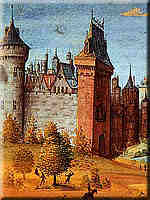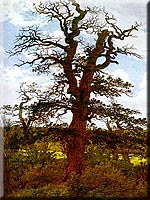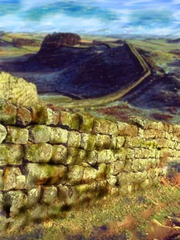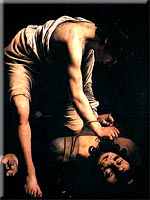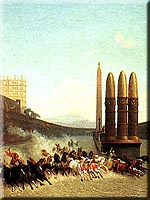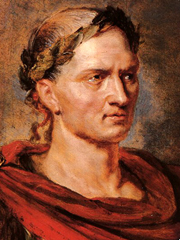SpiritWars™
Guide to Playing Pieces
Physical Spirits: As physical spirits leave the courtyard of your castle, they assume a physical presence on the playing field (map). The control and movement of these spirits represent the physical aspects of SpiritWars. The Castles:
The fundamental concept of SpiritWars dates back to one the oldest strategy games: destroy your opponent's castle before he destroys yours and you win.
Each player begins the game with a castle on the playing field. As the game progresses, the players will summon creatures fromthe dungeon of the castle into the courtyard. From the courtyard, spirits may be activated and used in the game.
Castles can be damaged by direct attacks from combat pieces in play and by magical spells. If a castle ends a turn with a defense rating of zero or less, the game ends.
The one exception to this occurs if both castles have identical below-zero ratings. For example, both castles have a defense rating of -1. In that case, the game continues until one castle ends a turn with a lower defense rating than the other. There are no draws in the land of Valhalla. face="Georgia">
Energy Spirits: Almost every action in the game requires energy resources (or points). While the players' castles generate some energy points at the beginning of each turn and energy can be produced by magical spells, the Energy Spirits are the primary source of energy in SpiritWars.
These physical spirits normally have low defensive ratings, no offensive power and can not move. They do, however, have the ability to generate new energy resources at the beginning of each turn that they remain in play.
Energy spirits, when activated, can enter the playing field in anyhex on the map that is adjacent to a friendly-occupied space.
Most energy pieces create one energy point per turn, although some enhanced units can create more than one point (including a few like the Aqueduct that creates one blue and one white energy point each turn). Energy pieces that are placed on a terrain location that matches their Homeland receive an energy production bonus of one point per turn.
Defenders:
Like energy pieces, defenders can't be moved once they are positioned on the playing field. They also follow the same activation rules as the energy pieces, being placed in any empty map location adjacent to one of the player's pieces.
The distinguishing attribute of Defenders is that while they can not attack, they can intercept an enemy attack directed at another piece.
A Defender has a special attribute called "blocking range." If an attacking piece is within this distance from the Defender, thedefending player has the option of using the Defender to intercept that attack (thus defending the targeted piece).
The majority of Defenders have a "blocking power" of zero, which means that they absorb the intended damage and do no damage in response to the attack. If the Defender's blocking power is greater than zero, it has the ability to inflict damage on the attacking unit.
Defender's get the same defensive bonus when placed on their Homeland terrain type as do other combat pieces.Combat Units: The primary offensive tool in SpiritWars is the physical spirit which creates a combat unit. These are used to attack the opposing player's playing pieces and castle.
Combat units are the only physical playing piece that can be moved on the playing map. They must enter play, when activated, in one of the map locations adjacent to the player's home castle. If there are no adjacent spaces open, no new combat units may enter the playing field.
Study the individual attributes of each piece carefully.Finding a complementary collection of spirits for your dungeon is the key to success in SpiritWars.
Each combat piece has the ability to perform one move event and participate in one combat event per turn of play. For most pieces, the act of entering the playing field is considered tobe a movement event and they subsequently can't move until the following turn. Pieces with the "move first turn" attribute have the ability to move on the playing field in the same turn they are activated.
The game uses three different playing pieces, or icons, to represent combat spirits in play on the game map. These are designed to help the player quickly identify keypieces in play.
Perhaps the single most powerful attribute a combat piece can have is the ability to attack an opponent from a distance. Any piece with an attack range greater than one is represented on the playing field by the bow and arrow icon. (Keep in mind that if a combat piece has itsattack range enhanced by a magical spell, it will still be represented by the icon used when it first entered the field of play.)
The ability to move quickly across the playingfield is another significant ability a combat piece may possess. If it doesn't have the ability to conduct long-range attacks, but it does have a "movement range" rating greater than one, it will be represented by the horse icon.
Keep in mind that a piece that has both fast movement and long-range attack abilities (like the Mounted Bowman)will be represented by the arrow icon since that is the more valuable ability.
The remaining combat pieces are represented on the map by the gold and silver shield icons. During game play, a summary of key attributes associated with that piece can be reviewed by right clicking on the selected piece. If more detailed information is required, from the small summary screen (in the upper right-hand corner of the playing screen) follow the "View Card Detail" button for a complete report on all aspects of the spirit's abilities and attributes.
